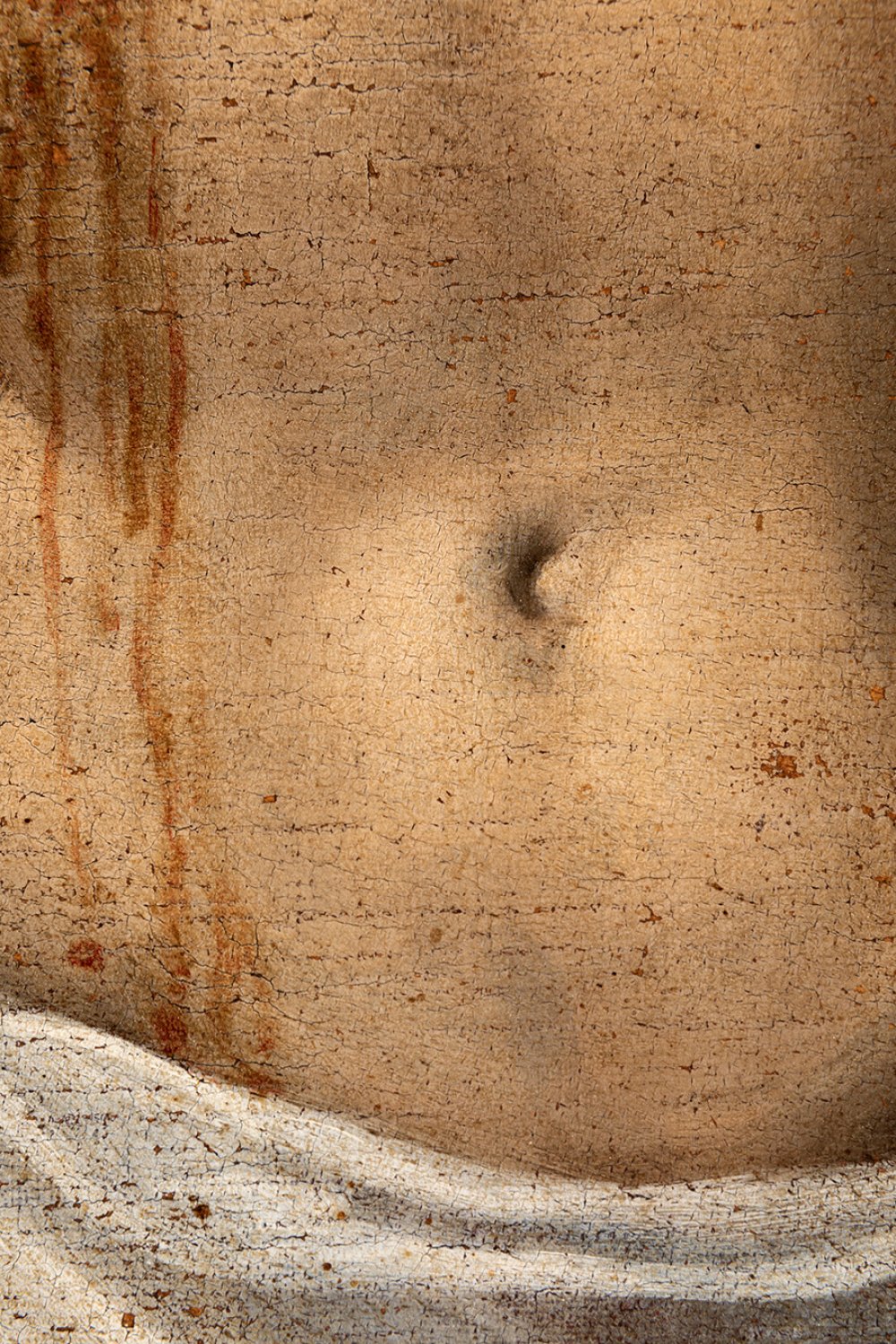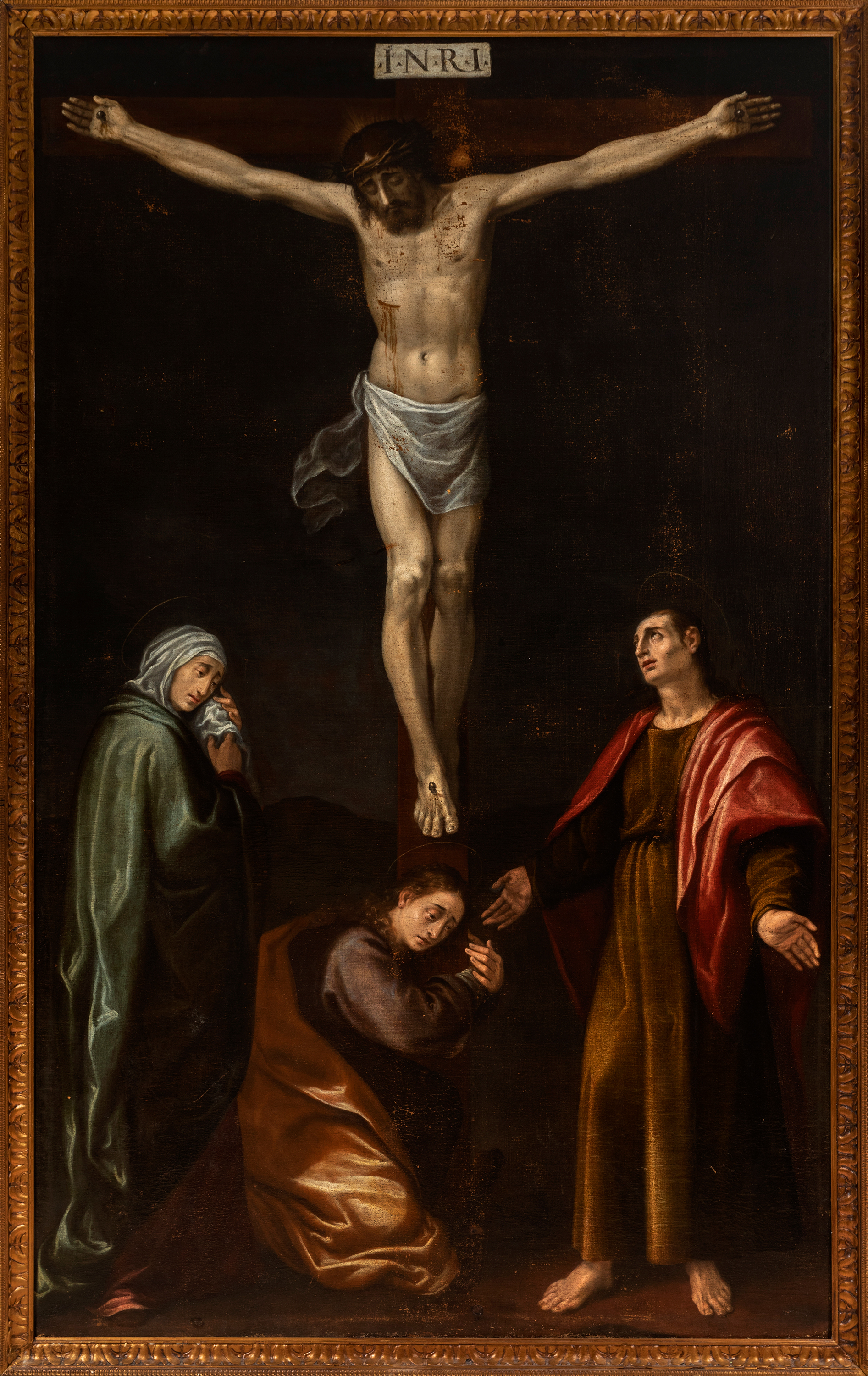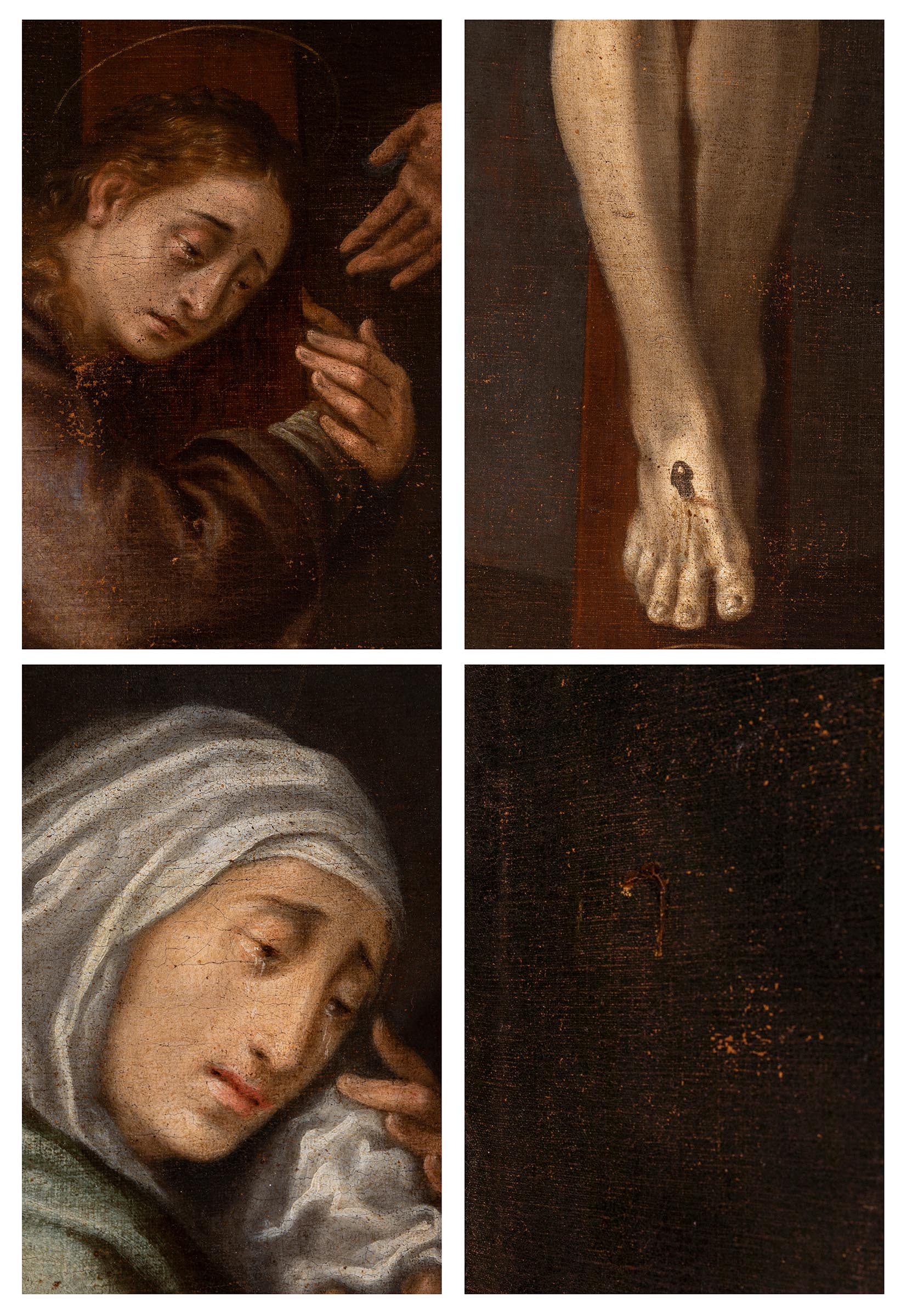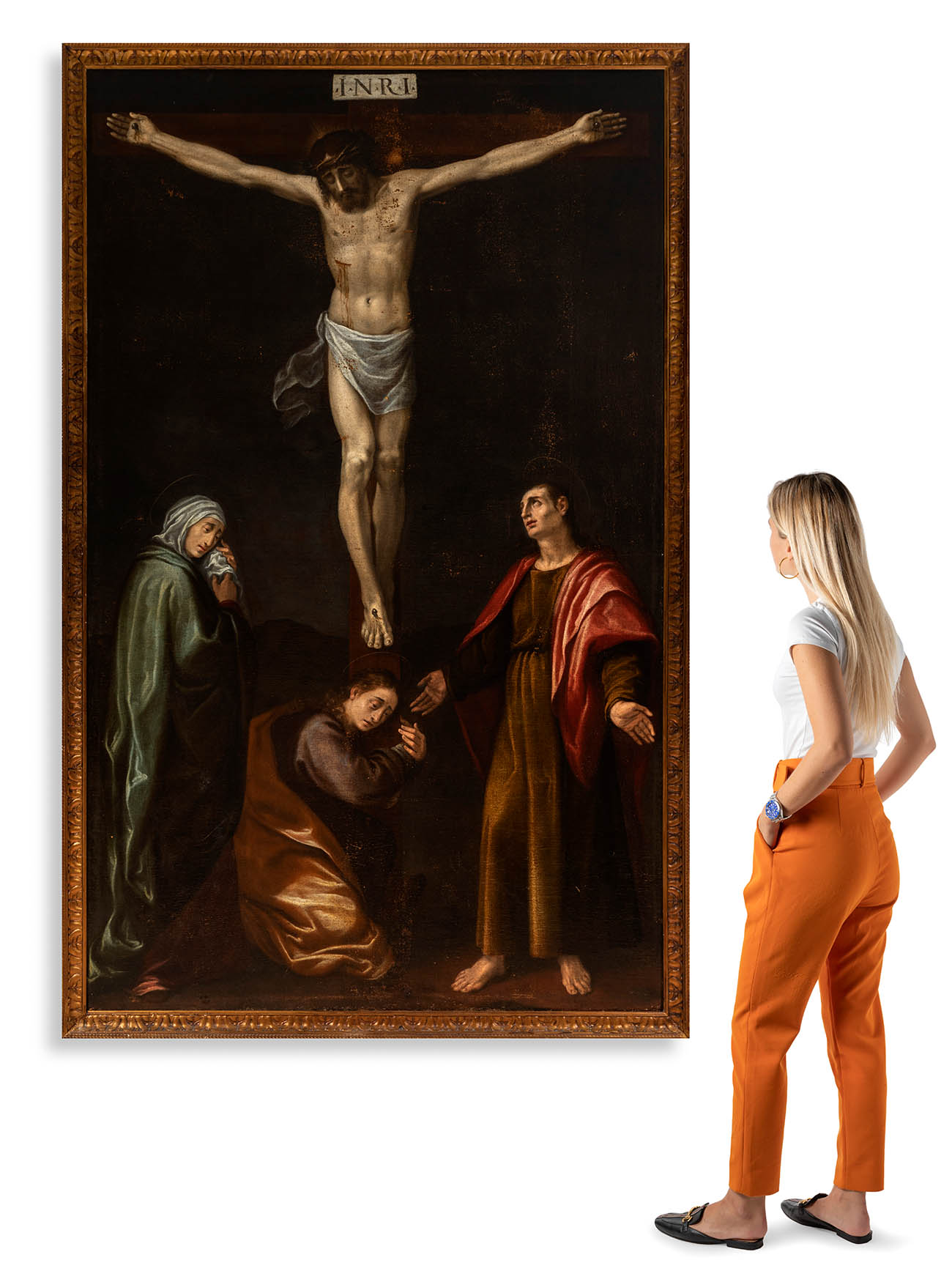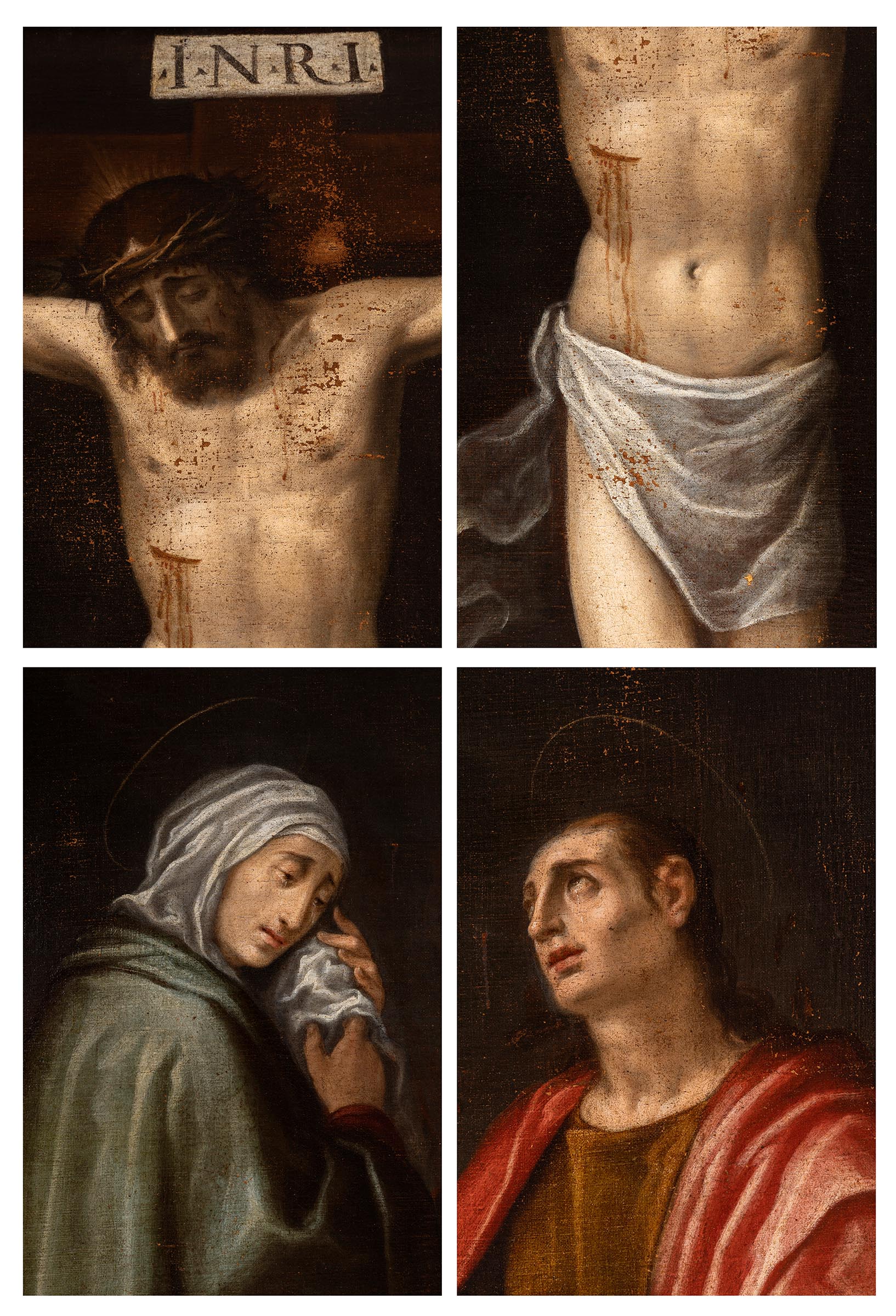10
Toledo school of the first third of the 17th century."Calvary".Oil on canvas.In its original
"Calvary".
Oil on canvas.
In its original canvas.
It presents repainting, leaps and faults.
Frame of the 20th century.
Measurements: 220 x 135 cm; 227 x 143 cm (frame).
Due to its stylistic characteristics, the work in question shows that it belongs to the Spanish school of the first third of the 17th century, having to be considered as anonymous of the Toledo school. This painting depicts the Crucifixion with the Virgin, Saint John the Evangelist and Mary Magdalene at the foot of the Cross, an iconographic form evolved from the original Byzantine Déesis, which depicted Christ in Majesty accompanied by Mary and Saint John the Baptist. In Western art, the representation of Christ on the cross was preferred as a narrative scene, and the figure of John the Baptist was replaced by that of John the Evangelist. This image, in its conception and form, is the result of the expression of the people and their deepest feelings. The composition of the present work is based on the Gospel text, which is why all the figures are clearly depicted against a neutral background that emphasises their corporeality. Jesus is clearly highlighted in the centre, illuminated, with a less contrasting and chiaroscuro treatment than the other figures. At a formal level, the monumentality of the figures is also noteworthy, worked with a markedly sculptural sense that derives in part from the influence of Michelangelo, filtered through the Roman-Bolognese classicists. The result is a painting that combines with balance and mastery the two great trends that shaped the Baroque at European level: the classical in the figures, the eloquent theatricality of the gestures and the classical chromatism, applied in large fields, and the naturalist derived from Caravaggio and his followers, reflected in the careful and effective study of light. With the economy of the state in ruins, the nobility in decline and the clergy heavily taxed, it was the monasteries, parishes and confraternities of clerics and laymen who encouraged its development, with works sometimes financed by popular subscription. Painting was thus obliged to express the prevailing ideals in these environments, which were none other than religious ones, at a time when Counter-Reformation doctrine demanded a realistic language from art so that the faithful could understand and identify with what was depicted, and an expression endowed with an intense emotional content to increase the fervour and devotion of the people. Religious themes were therefore the preferred subject matter of Spanish sculpture of this period, which in the early decades of the century was based on a priority interest in capturing the natural world, gradually intensifying over the course of the century in the depiction of expressive values, which was achieved through movement and the variety of gestures, the use of light resources and the representation of moods and feelings.
"Calvary".
Oil on canvas.
In its original canvas.
It presents repainting, leaps and faults.
Frame of the 20th century.
Measurements: 220 x 135 cm; 227 x 143 cm (frame).
Due to its stylistic characteristics, the work in question shows that it belongs to the Spanish school of the first third of the 17th century, having to be considered as anonymous of the Toledo school. This painting depicts the Crucifixion with the Virgin, Saint John the Evangelist and Mary Magdalene at the foot of the Cross, an iconographic form evolved from the original Byzantine Déesis, which depicted Christ in Majesty accompanied by Mary and Saint John the Baptist. In Western art, the representation of Christ on the cross was preferred as a narrative scene, and the figure of John the Baptist was replaced by that of John the Evangelist. This image, in its conception and form, is the result of the expression of the people and their deepest feelings. The composition of the present work is based on the Gospel text, which is why all the figures are clearly depicted against a neutral background that emphasises their corporeality. Jesus is clearly highlighted in the centre, illuminated, with a less contrasting and chiaroscuro treatment than the other figures. At a formal level, the monumentality of the figures is also noteworthy, worked with a markedly sculptural sense that derives in part from the influence of Michelangelo, filtered through the Roman-Bolognese classicists. The result is a painting that combines with balance and mastery the two great trends that shaped the Baroque at European level: the classical in the figures, the eloquent theatricality of the gestures and the classical chromatism, applied in large fields, and the naturalist derived from Caravaggio and his followers, reflected in the careful and effective study of light. With the economy of the state in ruins, the nobility in decline and the clergy heavily taxed, it was the monasteries, parishes and confraternities of clerics and laymen who encouraged its development, with works sometimes financed by popular subscription. Painting was thus obliged to express the prevailing ideals in these environments, which were none other than religious ones, at a time when Counter-Reformation doctrine demanded a realistic language from art so that the faithful could understand and identify with what was depicted, and an expression endowed with an intense emotional content to increase the fervour and devotion of the people. Religious themes were therefore the preferred subject matter of Spanish sculpture of this period, which in the early decades of the century was based on a priority interest in capturing the natural world, gradually intensifying over the course of the century in the depiction of expressive values, which was achieved through movement and the variety of gestures, the use of light resources and the representation of moods and feelings.
13th October - Old Masters
Sale Date(s)
Venue Address
General delivery information available from the auctioneer
Setdart offers Worldwide shipping
PICK UP IN ROOM: You can come and pick up your lots in our offices (Barcelona, Madrid or Valencia). At the moment of the withdrawal, you will be able to accept the current conditions of the lot by means of a document that you will sign.
YOU CAN SEND ANOTHER PERSON TO PICK UP: This person must present a signed authorization that you can find in our web page by accessing from BUY AT SETDART- LOGISTICS-DOWNLOAD AUTHORIZATION DOCUMENT. You can also send an e-mail with the requested data in AUTHORIZATION DOCUMENT to admin@setdart.com
Important Information
25% buyer´s premium
21% buyer´s premium at www.setdart.com
Terms & Conditions
The maximum period to pay the lots is 7 working days. You can pay either via bank transfer or with credit card through our platform www.setdart.com (we only accept VISA or Mastercard).
BUYER´S PREMIUM: 22% Hammer price + 21% VAT from the buyer´s premium
If your piece has more than 100 years, our Ministry of Culture requires an export certificate in order for the piece to leave the country. Note that if the piece goes inside the EU, there is no cost for the export certificate. If the piece goes outside the EU, there is a cost for the export certificate. You can find more information in our Ministry of Culture website: https://www.culturaydeporte.gob.es/en/cultura/patrimonio/exportacionimportacion/exportacion/tasas.html
INQUIRIES: admin@setdart.com
Setdart guides you through the entire process, from the time of award to the day you receive your lot. Our logistics team will be happy to manage your transport, and will advise you on the best shipping method with professionals from the sector used to handling works of art and jewelry.
WE OFFER WORLDWIDE DOOR TO DOOR SHIPPING
PICK UP IN ROOM: You can come and pick up your lots in our offices. At the moment of the withdrawal, you will be able to accept the current conditions of the lot by means of a document that you will sign.
YOU CAN SEND ANOTHER PERSON TO PICK UP: This person must present a signed authorization that you can find in our web page by accessing from BUY AT SETDART-LOGISTICS-DOWNLOAD AUTHORIZATION DOCUMENT. You can also send an e-mail with the requested data in AUTHORIZATION DOCUMENT to admin@setdart.com
SETDART IS NOT RESPONSIBLE FOR THE STATE OF THE PARTS ONCE THEY LEAVE OUR FACILITIES. MRW SHIPMENTS: Once the payment is made, your lot will be packed for shipment, the logistics department will send you an e-mail notifying you of the day it leaves our warehouse, changes of address cannot be made after receiving this e-mail.
INSURANCE INCIDENTS: Coverage for the value of the auction up to 3000 ? per shipment, if the value of the auction is higher, Setdart will send you a quote including the additional insurance. The insurance company WILL NOT BE RESPONSIBLE FOR THE SHIPMENT THAT EXCEEDS THAT AMOUNT AND IS NOT FULLY INSURED. MRW INCIDENTS: Maximum notification 48 hours after receipt, after which the insurance company WILL NOT BE RESPONSIBLE AND NO CLAIMS WILL BE ACCEPTED.
E-MAIL LOGISTICS: logistica@setdart.com
PICK UP YOUR MESSAGES: You can send your own messaging, prior notice via e-mail that your shipment is ready, please note 3 or 4 days in advance. This type of shipment is packaged so Setdart will provide you with a quote.
EXPENSES FOR STORAGE: We inform you that if the purchased lot is not picked up within a month, you will be charged 30€ per week per lot. Setdart Online S.L., owner of the web site "setdart.com", "setdart.net" and "setdart.org", acts as a company of Spanish nationality inscribed in the Volume 36955, sheet 182, page B-293056 of the Mercantile Registry, with registered office at Calle Aragó














